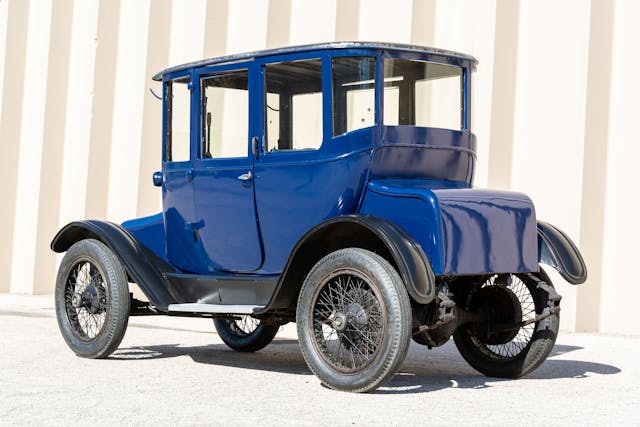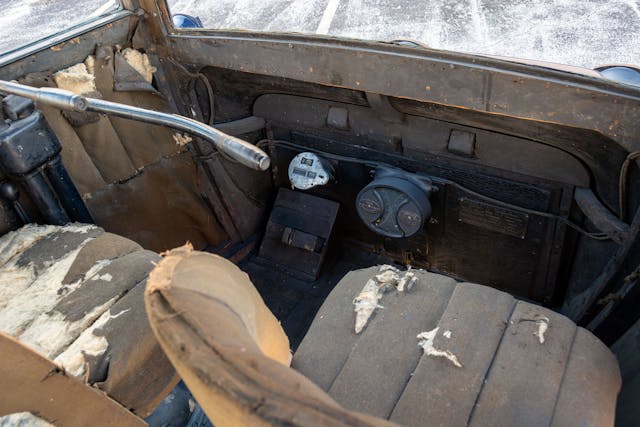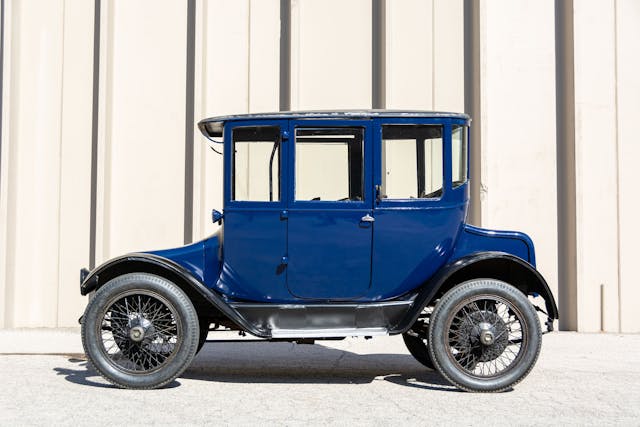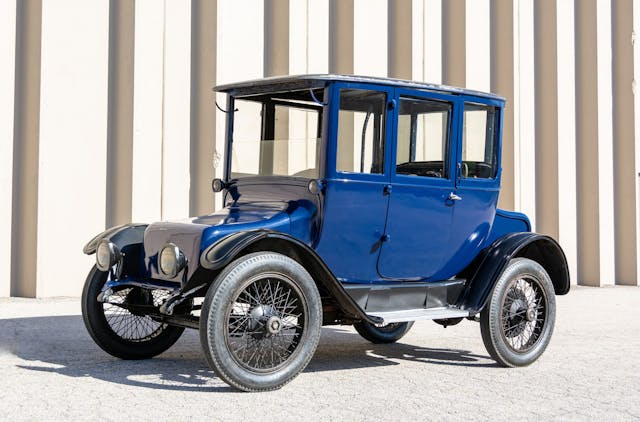How we’d EV swap this old-school Detroit Electric with new-wave tech
Those of us excited about how electric motors can be used creatively in vintage cars are always curious about potential swaps, but modifying existing EVs is an equally interesting idea. The usual concept of a resto-mod entails updating what’s already under the hood—why not expand that approach to alternative powertrains?
Thanks to robust interest from vehicle manufacturers, the international supply chain has answered the call with a slurry of new technology and production capabilities, driving down the costs of individual components parts. That applies especially to the batteries and motor controller hardware/software. Recently, we’ve even seen mainstream aftermarket companies like Holley and AEM begin to develop tools for these new powerplants that resemble ECU tuning solutions for traditional combustion engines.
For fun, let’s pretend our project car is the 1922 Detroit Electric that just closed at $33,000 in an RM Sotheby’s auction today. It kind of fits the flavor of a typical pre-war foundation for a hot rod, and it represents the starting point for a century of development. With less than 5 hp and a screaming top speed of 25 mph, the Detroit’s performance could best be described as “modest.”
Underneath the phonebooth-like cabin was a bank of several dozen Edison Alkaline battery cells. Instead of using a motor controller or anything complicated in order to meter the battery packs’ total capacity of 84 volts, the Electric relies on batches of batteries that switch on in order to bump the motor voltage for different speeds. Imagine car with the throttle tied to the spark plugs: The more you press the throttle, the more cylinders it lights off instead of just metering the airflow of every cylinder together with a throttle body. While this design lacks an element of finesse, it was a reliable solution compared to using resistor banks, which dissipated extra power as heat to have a “low” throttle (unlike today’s motor controllers, which bias power to the motor in different ways to achieve the targeted output).
Okay, so stop-light performance for this old thing isn’t quite Ludicrous Mode, but at least the range is within reason for modern BEVs. With an estimated 75 to 100 miles of travel between charges when it was originally built, that range puts it on par with the likes of the much more recent Fiat 500E and Ford Focus EV. If we were to hot rod this thing a bit, we’d essentially be swapping the whole electrical and motor system out for modern gear. In this context, however, it would be more like replacing the engine, transmission, and fuel system in a normal project car.

The foundation of any EV is its batteries, as the battery configurations and chemistries dictate much of the character of the vehicle. Some cells are designed for lower output, but higher capacities; others trade off outright power density in exchange for a little extra current output. The Detroit Electric has the stance of a daddy long-leg spider, especially with those skinny wheels, so let’s hone in on something that drives well and has enough performance to play with modern traffic. We’ll take a nod from Jay Leno’s Garage here and steer toward Nissan Leaf battery cells. Their Achilles heel in the Leaf is the fact that these cells are designed to operate air-cooled but are prone to overheating in hot climates; this works in our favor with the Detroit. It’s substantially lighter, and with the Detroit’s bicycle tire’s worth of contact patch on each corner, we can’t throw a bunch of current at it anyway, so the demand will be much less. Also favorable: the batteries won’t require an additional cooling system with a small radiator to dissipate heat, as there’s no real grille ducting on the all-electric Detroit chariot.
Keeping the install simpler without ruining the antique aesthetics? Those traits, along with their OEM-approved durability and relatively low cost on the market, makes this the perfect starting point for our imaginary build. Jay mentions having 3D printed the case, but the reality is that the cells need to simply be compressed together by any kind of materiel that bear-hugs them. This helps contain their shape as they expand and contract with use, and helps to package the cells into their final configurations to build the battery’s output and capacity specs.
Because we’re not going for crazy performance here, a light-duty motor can be selected to power the original live-axle. We’ll just be modest here with an HPEVS AC-34, which according to EV West makes 10 times the horsepower as the original DC motor. This AC-34 is a modern brushless AC motor with 108 lb-ft of torque right off the line, in which there are no carbon brushes (which transmit power to the motor by riding on the shaft like a lifter) to wear out or create friction. It’s managed by a Curtis 1238-6501 motor controller, is capable of passing 550 amps and has more than enough headroom for our mouse motor. Given that this is a 48v system, we would only need six Leaf cells wired in series to hit the voltage, meaning that we can wire them in parallels blocks of six cells in order to build up extra battery capacity. I strongly suspect 48 cells could fit under the frunk and trunk of this Detroit, essentially creating a 6S8P pack. We’d need to toss a battery management system into the build list, which carefully manages the cells state of charge and safety measures, but there’s a myriad of modular solutions out there, and even Dilithium’s $500 BMS system could be configured for our Detroit.

The neat part about this is that because we’re essentially dealing with electrical switches for the main controls, it wouldn’t be too difficult to add some form of throttle position sensor to the original tiller handle in the cab with the motor controller programmed to accept it. There’s no more finagling a throttle cable into some steampunk nightmare to snake it around the new powerplant, nor playing with transmission linkage geometries to try and get a column shifter to select gears on a foreign transmission. Without the mechanical connections to the driveline that would normally be essential for operation, an EV build like this frees up some packaging stress ordinarily associated with a swap.
There’s a lot of potential here to dream about chopping the roof down or sectioning the body of the Detroit to bring its proportions into a leaner, meaner stance—but then maybe we’d have to rethink the restrained powertrain and just go full-hog with some tire-shredding Tesla-motored freak. Nevertheless, we’ve managed to keep the price reasonable. The aforementioned HPEVS kit is a stinking deal at $4225 with the motor and controller together plus the associated hardware to marry them, and with Leaf cells ranging on average from $40-75 per unit (depending on how large of a batch is ordered) as of the time this writing, let’s just agree that we sink $3000 into the batteries. We’re $7500 into a total resto-mod of the original Detroit driveline, with 10 times more power and much better drivability. If a Model A can cruise at 55 mph, maybe the Detroit’s chassis and suspension performs similarly well, and this would provide more than enough power to reach those speeds.
Okay, now that we’ve got the gears in your head churning, tell us your wildest electric-powered ideas. Dream big!




Is this in Detroit?